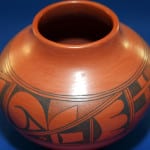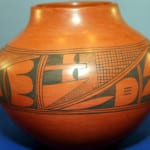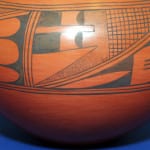This pot is made of “sikyatska,” yellow clay that fires red. The clay has different properties than the more common grey clay (that fires gold/tan) and is said to be more difficult to work. Pots made from made of sikyatska seem to be finer-grained, with exceptionally slick surfaces. The beeweed/hematite paint used for the black design does not seem to penetrate the surface of such pots very much; as a result sikyatska pots often have their design partially worn off. That is not the case with jar 2010-27, but the pot has a gentle (almost porcelain) glow to the surface and the design has a gentle, subdued look.
The neck of the jar is pebble-polished on the inside; the form is simple and elegant. The black band of typical Hopi/Tewa design elements is framed by delicate bands and is highlighted by substantial areas of undecorated space above and below.
Lorna (b. 1930) signs her pot with the same flower image used by her mother (Sadie Adams) but adds an “LL” to distinguish her work. She has been an active potter since 1970.
This pot is one of a group of pots that were part of a 2,400-item Southwest pueblo pottery collection that was assembled by Rutt Bridges of Denver, CO over a period of about 14 years. His sister, Kathleen Hoff, is helping her brother sell the collection. In 2009, Kat sent me two CDs with information about Hopi pots in the collection. During 2010, over a period of months Kay sent me additional photographs of about 200 Hopi and Hopi/Tewa pots from the collection.







